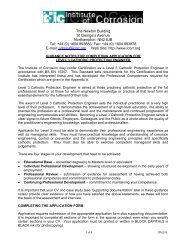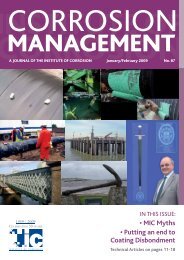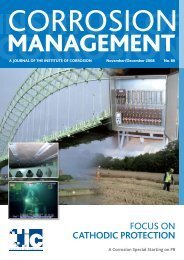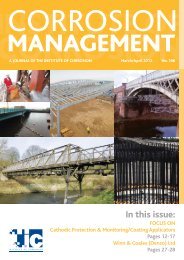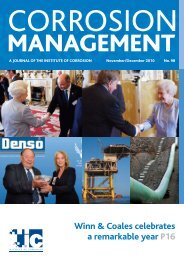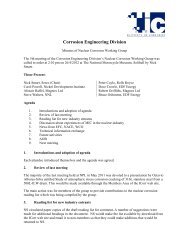CorrosionManagement | September/October 2009TECHNICALARTICLEvari<strong>at</strong>ion between different areas of thesandbox. It is also possible th<strong>at</strong> the form<strong>at</strong>ionof the passive film on the steel section, thedesired consequence of applying CP, doesnot occur evenly leading to some variability.Despite these errors the boundary elementmethod provides sufficiently accur<strong>at</strong>e resultsto produce potential and current distributionmaps for the surface of buried steel elementsand identify areas of excessive or inadequ<strong>at</strong>epolaris<strong>at</strong>ion, as shown in Figure 7.5. Stray current effectsFigure 6: Comparison of experimental andmodelled potential line scan for steel beamin sand.Figure 7: Potential distribution on the surface of a steel beam subject to c<strong>at</strong>hodic protection,as modelled by the boundary element method.Figure 8: Sand box test to assess stray current effects.Steel-framed masonry buildings contain avariety of metallic elements. In addition tothe frame itself, metal window frames, drainpipes and fixings such as wall ties and clampsare commonly encountered. Generallyelectrical continuity between structuralmembers is rarely a problem [9] since thestructural connections are typically boltedor riveted. However, other elements aremore likely to be electrically discontinuousand this must be taken into account whendesigning a CP systems. Failure to ensure theelectrical continuity of all metallic elementscould result in stray current interactionsbetween the various elements of thestructure, resulting in acceler<strong>at</strong>ed corrosionof the discontinuous items.By employing the boundary elementmethod, it has been possible to modelthe effect of discontinuous steel on straycurrent corrosion and the results have beencompared with weight loss measurementsfrom sand box tests, as shown in Figure 8. Themodel predicts the steel between the anodeand the steel section will pick up currenton the face nearest the anode and releasecurrent on the face nearest the steel section,the l<strong>at</strong>ter resulting in a loss of metal. For theother bar, while there is some pick up, thereis rel<strong>at</strong>ively little loss and consequently littleor no corrosion [10]. Estim<strong>at</strong>ed weight lossesbased on the modelled currents comparedwell with actual weight loss measurementsobtained from the bars, demonstr<strong>at</strong>ing thevalidity of the boundary element methodfor assessing the effects of stray current ondiscontinuous metallic items.6. Design implic<strong>at</strong>ionsHaving demonstr<strong>at</strong>ed the adequacy of themodel, it has subsequently been employedto assist in the detailed design of c<strong>at</strong>hodicprotection systems for historically significantsteel framed structures. The model can assistin the optimis<strong>at</strong>ion of anode loc<strong>at</strong>ions intwo ways. Firstly, it can help identify the bestloc<strong>at</strong>ions for anodes so as to achieve fullprotection from the least number of anodes,12
CorrosionManagement | September/October 2009TECHNICALARTICLEFigure 9: Completed CP install<strong>at</strong>ion to a heritage steel framed building.this in turn reduces the number of holes th<strong>at</strong>have to be made in the structure and savesboth money and resources. The second wayin which the model can be of benefit is wherethere are preferred loc<strong>at</strong>ions for anodes, forexample <strong>at</strong> joints, and the adequacy of theprotection afforded by these anode loc<strong>at</strong>ionscan be assessed prior to install<strong>at</strong>ion.7. Future workThe model gener<strong>at</strong>ed from this work alsohas potential as a development tool forimproving the performance of CP systemsand overcoming a number of the practicalproblems presently encountered. Theability of the model to accommod<strong>at</strong>e straycurrent effects should make it possible toimprove the present methods of dealing withdiscontinuous metallic items, such as clampsand wall ties. It should also be possible todevelop more efficient systems with savingsin both the cost of install<strong>at</strong>ion and the longterm running costs.One area considered worthy of furtherinvestig<strong>at</strong>ion with the assistance of themodel is the employment of pulsed powersupplies which have only previously beenemployed commercially in oil and gasapplic<strong>at</strong>ions [11]. Such systems, if found tobe workable, could increase the efficiencyof the CP install<strong>at</strong>ions and reduce both thenumber of anodes required and the extent ofstray current effects on discontinuous itemsto provide more practical and sustainablesolutions for the preserv<strong>at</strong>ion of steel framedheritage structures.8. ConclusionsBy employing the sand box technique, anapproach more commonly used in the studyof pipeline CP, it has been possible to verifythe validity of numerical modelling based onthe boundary element method for optimisingelectrochemical remedi<strong>at</strong>ion systems forhistoric steel framed structures.Labor<strong>at</strong>ory tests on simple masonry encasedsteel samples have further confirmed theaccuracy of the method in predicting thedistribution of c<strong>at</strong>hodic protection on actualstructures. Such modelling has subsequentlybeen employed in the design of CP systemsfor major heritage structures and has provedvaluable in allowing the loc<strong>at</strong>ion and numberof anodes to be optimised, thereby reducingboth the costs and level of damage to theoriginal building fabric.It is hoped th<strong>at</strong> further studies on pulsedpower supplies will result in simpler systemsand permit more widespread applic<strong>at</strong>ion ofthis remedi<strong>at</strong>ion technique.9. AcknowledgementsThe role of the Royal Society, Sheffield HallamUniversity and Mott MacDonald in the supportof this study is gr<strong>at</strong>efully acknowledged.10. References[1]. Davy H, ‘On the corrosion of coppersheeting by seaw<strong>at</strong>er, and on methods ofpreventing this effect, and on their applic<strong>at</strong>ionto ships of war and other ships’. Proceedingsof the Royal Society, 114, pp.151-246, 1824and 115, pp.328-346, 1825.[2]. Evans B, ‘Electric Refurbishment’, TheArchitects’ Journal, pp 59-61, November1997.[3]. Lambert, P, ‘Corrosion mechanisms– an introduction to aqueous corrosion’,Corrosion Prevention Associ<strong>at</strong>ion, TechnicalNote No.5, 2001.[4]. Lambert P & Atkins C P, ‘C<strong>at</strong>hodicprotection of historic steel framed buildings’,Structural Studies, Repairs and Maintenanceof Heritage Architecture XI, Malta, pp 491-500, 2005.[5]. Lambert P, Mang<strong>at</strong> P S, O’Flaherty FJ &Wu Y-Y, ‘C<strong>at</strong>hodic protection of steel framedmasonry structures - experimental andnumerical studies’ M<strong>at</strong>erials & Structures,RILEM, M<strong>at</strong>erials and Structures, 41, March2008, pp. 301-310.[6]. Hassanein A M, Glass G K & Buenfeld NR, ‘Potential current distribution in reinforcedconcrete c<strong>at</strong>hodic protection systems’,Cement & Concrete Composite, 24, pp.159-167, 2002.[7]. Adey R A, Niku S M, Brebbia C A &Finnegan J, ‘Computer aided design ofc<strong>at</strong>hodic protection’, Boundary ElementMethods VII, Villa Olmo, Lake Como, Italy,1985.[8]. Lambert P & Wu Y-Y, ‘Electrochemicalmethods for the preserv<strong>at</strong>ion of masonryclad structural frames’, Maritime Heritageand Modern Ports, Proceedings of the SecondIntern<strong>at</strong>ional Conference on MaritimeHeritage, Barcelona, pp 219-228, 2005.[9]. Atkins C P, Lambert P & Coull Z L,‘C<strong>at</strong>hodic protection of steel framed heritagestructures”, 9th Intern<strong>at</strong>ional Conferenceon Durability of Building M<strong>at</strong>erials andComponents, Brisbane Convention &Exhibition Centre, Australia, 11pp, 2002.[10]. Wu Y-Y ‘C<strong>at</strong>hodic protection of steelframed masonry structures’, PhD Thesis,Sheffield Hallam University, UK, 2005.[11]. Bich N N & Bauman J, ‘Pulsed currentc<strong>at</strong>hodic protection of well casings’,M<strong>at</strong>erials Performance, Vol. 34, No. 4, pp17-21, 1995.13



